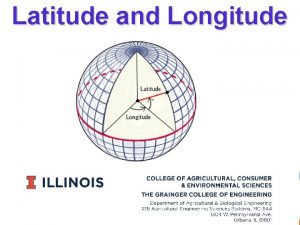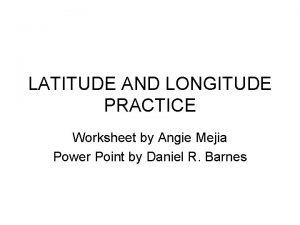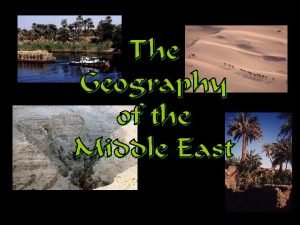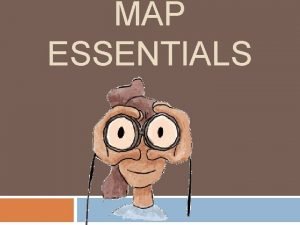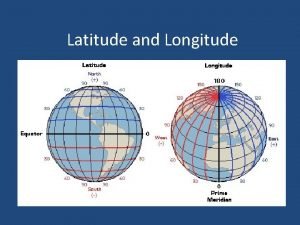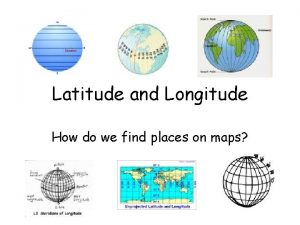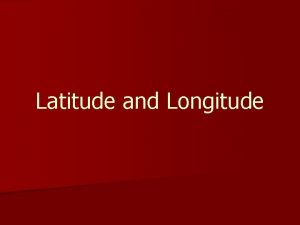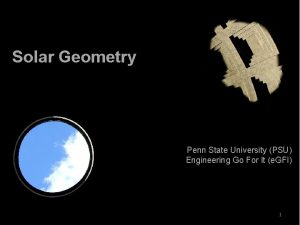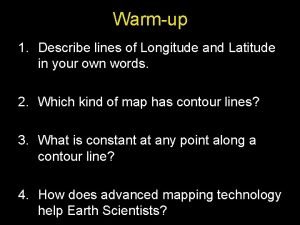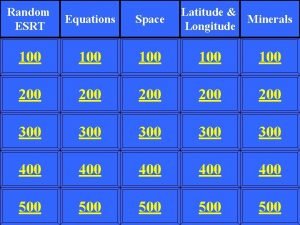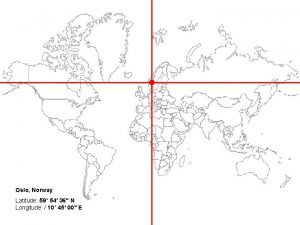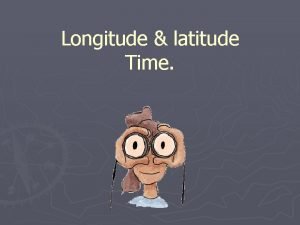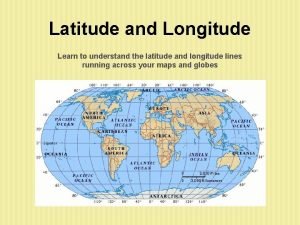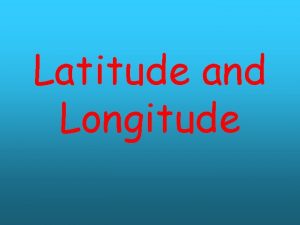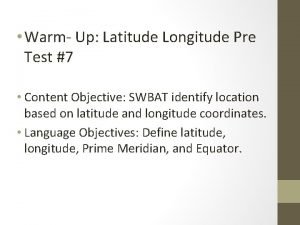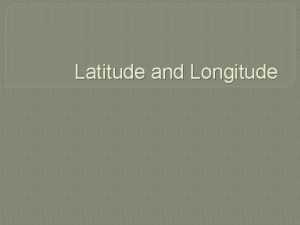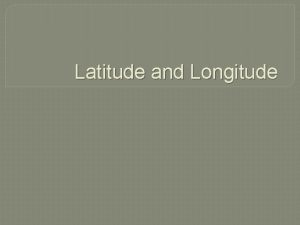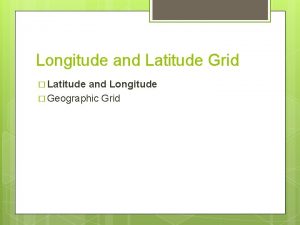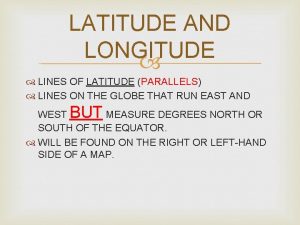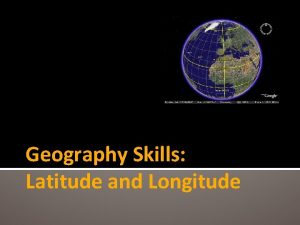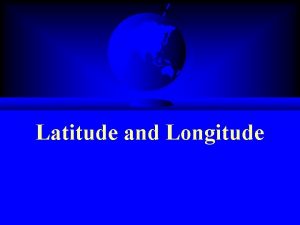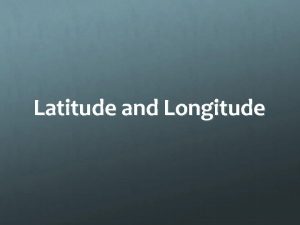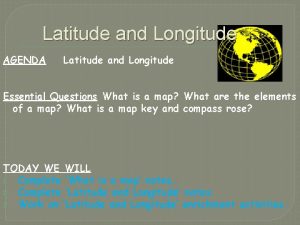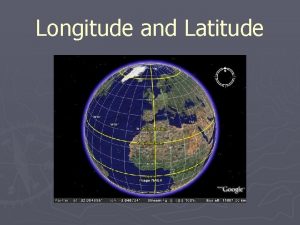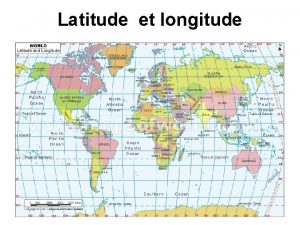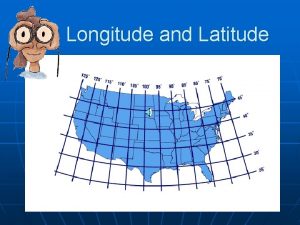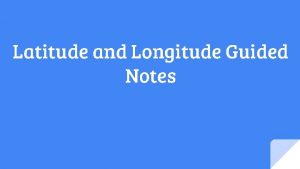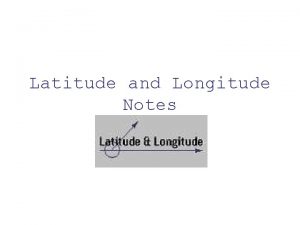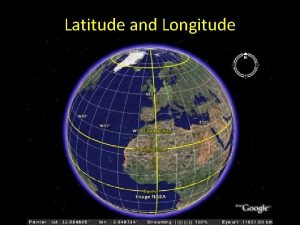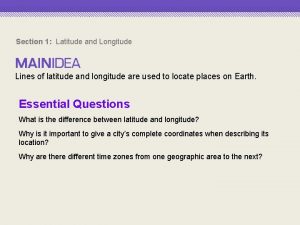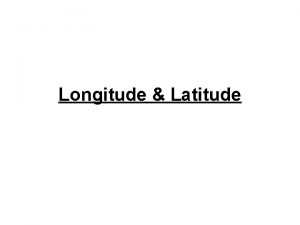Latitude Longitude History Use of grid lines originated























- Slides: 23

Latitude Longitude

History • Use of grid lines originated from about 300 B. C. E by Greek astronomers Hipparcus and Ptolemy • Used spherical trigonometry observations using sun, moon, and stars to plot points on a spherical earth • About 225 B. C. E, Eratosthenes measured circumference of the earth.

History • Knowing these dimensions, latitude was easily calculated. • Measured sun’s angle at noon relative to the equator. • Noon was determined simply from the highest point of the sun. • Longitude was much harder to calculate, however

History • East-west distance from one place to another on the earth could be plotted from position of sun and stars, but only if the time difference between the two places was known. • Inexact until invention of telescope and an accurate clock in the 16 th century • 1760, John Harrison invented an exact marine chronometer.

Lines of longitude only Equator added Other lines of latitude added

Cross-section through line of longitude Crosssections through lines of latitude

Latitude • “Lat is Flat” • Latitude lines run horizontally and are also known as parallels • Each degree of latitude is approximately 69 miles apart, but there is some variation due to the earth being an oblate ellipsoid.

Latitude • Equator is latitude line of 0 degrees. • Values indicate angular distance between Equator and points north or south of the surface of the Earth • Degrees latitude are numbered from 0 – 90 north and south (90 N is North pole; 90 S is South pole)

Longitude • Longitude lines run vertically and are also called meridians. • • Converge at poles and are widest at equator • Zero degrees longitude is located at Greenwich, England. Established in 1884. “Prime meridian”.

Longitude • Degrees continue 180 degrees east and 180 degrees west where they meet and form the International Date Line

Map Projections

What is a Map Projection? • A mathematical expression used to represent the 3 D surface of the earth on a 2 D map • Always results in distortions Source: http: //support. google. com/earth/bin/answer. py? hl=en&answer=148111

Projection Surfaces • Cylindrical – Meridians and parallels are equidistant, straight lines, crossing at right angles • Conical – Parallel(s) that are touching the cone are assigned unitary scale • Planar – Point or circle that intersects tangent plane has no distortion Source: http: //en. wikipedia. org/wiki/Map_projection#Projections_by_surface

Preservation of a Metric Property • Conformal- Preserves angles locally • Equal-area- Preserves area • Equidistant- Preserves distance from a standard point or line • Gnomonic- Preserves shortest route between two points (great circles projected as straight lines) • Azimuthal- Preserves cardinal directions • Compromise- Balancing/minimizing overall distortion Source: http: //en. wikipedia. org/wiki/Map_projection#Projections_by_surface

Projection Comparison Equal Area Projection Equal Angle Projection

Universal Transverse Mercator • Lat/Lon WGS 84 (UTM) used in Google Earth • Topographical maps, geological maps • Cylindrical, conformal • Large distortions at the poles • Greenland (blue) vs. Africa (red) example Source: http: //support. google. com/earth/bin/answer. py? hl=en&answer=148111 http: //www. pratham. name/mercator-projection-africa-vs-greenland. html

UTM projection • • • Universe Transverse Mercator Conformal projection (shapes are preserved) Cylindrical surface Two standard meridians Zones are 6 degrees of longitude wide

UTM zones

Zone 16 Zone 15


State Plane Coordinate System • System of map projections designed for the US • It is a coordinate system vs a map projection (such as UTM, which is a set of map projections) • Designed to minimize distortions to 1 in 10000

http: //www. avenza. com/sites/default/files/flashmaps/spsc/index. html

Illinois East 1201 Illinois West 1202
 Who invented latitude and longitude grid system
Who invented latitude and longitude grid system Latitudes and longitudes worksheet
Latitudes and longitudes worksheet Middle east latitude and longitude
Middle east latitude and longitude Map of world with longitude and latitude lines
Map of world with longitude and latitude lines Imaginary horizontal lines in the globe
Imaginary horizontal lines in the globe What do lines of latitude and longitude combine to make
What do lines of latitude and longitude combine to make Lines of latitude run blank and blank
Lines of latitude run blank and blank Lines that run east and west but measure north and south
Lines that run east and west but measure north and south Map with longitude lines
Map with longitude lines Lines of latitude and longitude
Lines of latitude and longitude Describe longitude and latitude
Describe longitude and latitude Highest point netherlands
Highest point netherlands Latitude song
Latitude song Random latitude longitude
Random latitude longitude Oslo norway latitude
Oslo norway latitude Longitude shape
Longitude shape 40° north latitude
40° north latitude How to read latitude and longitude
How to read latitude and longitude Krakatoa latitude and longitude
Krakatoa latitude and longitude Latitude and longitude of india
Latitude and longitude of india Lines of longitude
Lines of longitude Latitude and longitude test
Latitude and longitude test Angular distance latitude longitude
Angular distance latitude longitude Longitude
Longitude
